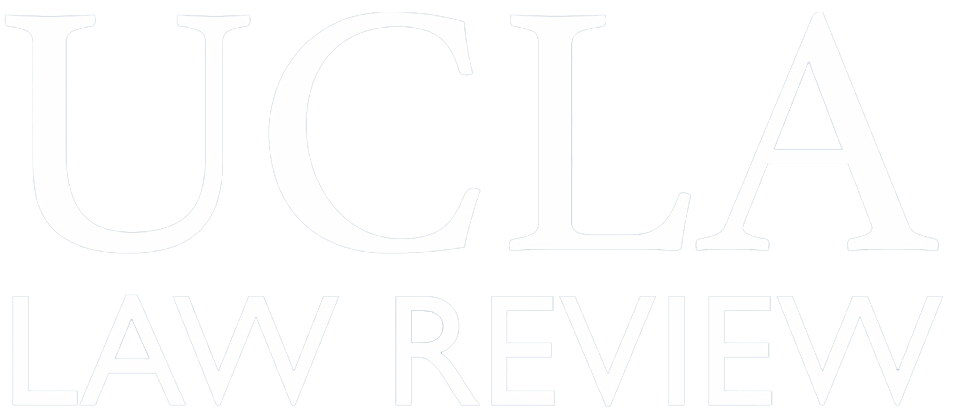The issue of compensating the wrongfully convicted has recently been thrust into public awareness. Over one hundred and fifty people have been exonerated through DNA evidence since 2000. Only half have received compensation for their time behind bars. While twenty-two states have enacted statutes that provide a direct legal right to compensation, these statutes require victims of wrongful...
Heightened Enablement in the Unpredictable Arts
A bedrock principle of patent law is that an applicant must sufficiently disclose the invention in exchange for the right to exclude. Essential to the disclosure requirement is enablement, which compels a patent applicant to enable a person having ordinary skill in the art (PHOSITA) to make and use the full scope of the claimed invention without undue experimentation. Enablement may be...
Melville B. Nimmer Memorial Lecture: The World of the Framers - A Christian Nation?
Each year, the UCLA School of Law hosts the Melville B. Nimmer Memorial Lecture. Since 1986, the lecture series has served as a forum for leading scholars in the fields of copyright and First Amendment law. In recent years, the lecture has been presented by distinguished scholars such as Lawrence Lessig, David Nimmer, Robert Post, Mark Rose, Kathleen Sullivan, and Jonathan Varat. The UCLA Law...
The iPhone Meets the Fourth Amendment
Under the search incident to arrest doctrine, police may search the entire body and immediate grabbing space of an arrestee, including the contents of all containers, without any probable cause. Because almost all traffic infractions are arrestable offenses, police have enormous opportunity to conduct such searches incident to arrest. In the near future, these already high-stakes searches will...
Implementing Greenhouse Gas Emissions Caps: A Case Study of the Los Angeles Department of Water and Power
Our almost forty-year experience with landmark federal environmental statutes, demonstrates unequivocally that implementing grand and noble environmental goals is an arduous and difficult experience. California is now embarking on a similar project: implementing the country’s most ambitious greenhouse gas emissions limitations, including rolling back the state’s emissions to 1990 levels by 2020...
The Place-Based Theory of Standing
Standing doctrine is well-known to be a quagmire, plagued by inconsistent results and judicial dissension. Worse, leading scholars have cast doubt on its historical pedigree and conceptual underpinnings. Yet, there seems to be little prospect for a radical change in direction. This Article proposes a more modest doctrinal shift. The proposed approach is much simpler than the current test, but...
Climate Change and the Transformation of Risk: Insurance Matters
Climate change will increase risks significantly in many areas of society, and also will make many risks more uncertain and harder to measure. If our society is to survive climate change without significant human costs, we must develop robust institutions and practices to manage these risks. The insurance industry is our society’s primary financial risk manager and needs to play a leading role in...
Like a Nation State
Using California’s self-consciously internationalist approach to climate change regulation as a primary example, this Article examines constitutional limitations on state foreign affairs activities. In particular, by focusing on the prospect of California’s establishment of a greenhouse gas (GHG) emissions trading system and its eventual linkage with comparable systems in Europe and elsewhere...
The World vs. the United States and China? The Complex Climate Change Incentives of the Leading Greenhouse Gas Emitters
It is generally agreed that the world would be better off with an international agreement to control greenhouse gas emissions. But it is not entirely clear that the leading emitters—the United States and China—would be better off with the agreement that would be in the world’s interest. The first problem is that as the largest emitters, the United States and China would probably have to bear a...
Individual Carbon Emissions: The Low-Hanging Fruit
The individual and household sector generates roughly 30 to 40 percent of U.S. greenhouse gas emissions and is a potential source of prompt and large emissions reductions. Yet the assumption that only extensive government regulation will generate substantial reductions from the sector is a barrier to change, particularly in a political environment hostile to regulation. This Article demonstrates...
Measuring the Clean Development Mechanism's Performance and Potential
The Clean Development Mechanism (CDM) of the Kyoto Protocol is the first global attempt to address a global environmental public goods problem with a market-based mechanism. The CDM is a carbon credit market where sellers, located exclusively in developing countries, can generate and certify emissions reductions that can be sold to buyers located in developed countries. Since 2004 it has grown...
Climate Change Policy and Policy Change in China
Solving the climate change problem by limiting global greenhouse gas (GHG) emissions will necessitate action by the world’s two largest emitters, the United States and China. Neither has so far committed to quantitative emissions limits. Some argue that China cannot be engaged on the basis of its national interest in climate policy, on the ground that China’s national net benefits of limiting...
The Judicial Carbon Tax: Reconstructing Public Nuisance and Climate Change
This Article seeks to reconstruct the public nuisance climate change cases Connecticut v. AEP and California v. General Motors to show that, while hardly perfect, nuisance litigation could form a reasonable basis for climate change regulation, at least as much as some of the other imperfect alternatives so far proposed. This nuisance system has promise because, as outlined here, it essentially...
An Imperative Redefinition of "Community": Incorporating Reentry Lawyers to Increase the Efficacy of Community Economic Development Initiatives
Life without economic subordination is recognized around the world as a fundamental human right. When individuals are economically impoverished, they are more likely to not only offend, but also repeatedly offend, because poverty compounded with the imposed civil disabilities of a criminal conviction further socially isolate and minimize their life options. This factual inference is not only...
